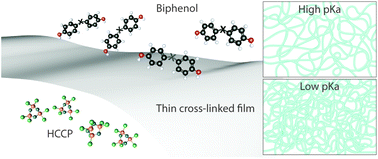Thin cyclomatrix polyphosphazene films: interfacial polymerization of hexachlorocyclotriphosphazene with aromatic biphenols
Abstract
A series of thin cyclomatrix polyphosphazene films has been prepared by interfacial polymerization of hexachlorocyclotriphosphazene (HCCP) with an aromatic biphenol. The pKa values of the biphenol used strongly influence the properties of the hyper-cross-linked films formed. 4,4′-Dihydroxybiphenyl (BPH) and 4,4′-dihydroxydiphenyl ether (DHPE) possess pKa values in the range of 9.4–9.6 & 10.0–10.3 for the mono- and di-ionized forms, respectively, and produce films with a lower cross-link density, whereas 4,4′-dihydroxybenzophenone (DHBP) and 4,4′-sulfonyldiphenol (BPS) feature lower pKa values (7.4–7.6 & 8.0–8.2), resulting in films with a higher cross-link density. The difference in cross-link density is reflected in, e.g., the surface morphology and mechanical properties of the films. Mechanical stiffness has been quantitatively assessed by PeakForce QNM AFM. Lower cross-link densities result in Young's moduli with average values of 44–69 MPa, with a sharp distribution, while higher cross-link densities yield broadly distributed Young's moduli with average values of 255–306 MPa, depending on the choice of the biphenol. The surface chemistry of the films was successfully altered by post-functionalization.



 Please wait while we load your content...
Please wait while we load your content...